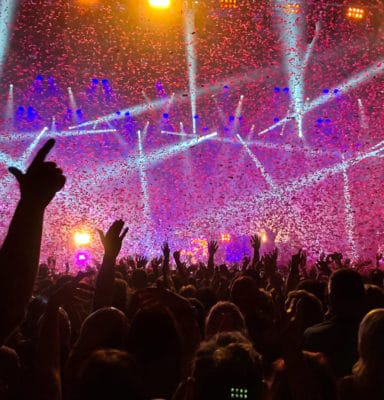By Tia Crawford
FIVE exciting trends that successfully break the two-dimensional exhibit barrier!
Now more than ever, events need to be a feast for the senses. Whether for a trade show booth, a fundraising gala, a product launch, or an advertising and marketing event, attendees must feel like the information presented is reaching out to grab them! Augmenting an event with 3-D interactive technology is an excellent way to involve guests’ eyes, ears, and touch in a way that is impossible to ignore.
Many Event Technology experts have predicted that “Augmented Reality”—the technique of using technology to enhance our sensory experience—may become increasingly common as we find new ways to incorporate virtual reality and technology-enhanced reality into our daily lives! We’ve identified FIVE exciting trends that successfully break the two-dimensional barrier, and help bring your company’s message straight into the sensory realm of your attendees!
- 3D Projection Mapping and Video Mapping – first-rate event lighting can create motion, pattern, and color effects of virtually any kind upon any surface. Customized “gobos” (that “Go Between” the optic) can change the beam of any light into logos or shapes. Rather than static and stationary lighting, video mapping allows Event Planners to create shapes and movement made from videos, light, and projection. 3D projection mapping and video mapping are lighting techniques that can turn any object into a display surface for lighting and video effects—giving your guests the feeling that they are part of the video!
- Holograms – holograms use lasers to create a precise image that appears truly three-dimensional. According to Wikipedia, “Holography is a technique which enables three-dimensional images to be made. It involves the use of a laser, interference, diffraction, light intensity recording and suitable illumination of the recording.”The holographic image changes with the position and orientation of the viewer, mimicking the experience of viewing an actual three-dimensional object, so holograms are remarkable in that they retain their illusion of reality even from different angles and perspectives. Some holograms can even appear to move as the viewer passes or they can change color or shape, depending on the perspective.
- IBeacons – iBeacons are a way to connect interactive elements with an attendee’s exact location as they move through an exhibit space. The beacons communicate wirelessly with a guests’ device, delivering relevant content that is tailored specifically to their position. Think of iBeacons as a traveling personal tour guide or as an invisible remote control—setting off amazing interactive displays, sound and other elements that make attendees feel that the show is created specifically around them.
- Sound Showers – sound showers are also known as “directional speakers”—and for good reason. Directional speakers create a highly-focused, amplified sound that is designed to deliver exceptional audio quality directly to a targeted area. Based on Panphonics “plane wave” technology, this award-winning Sound Shower® Directional Speaker System can create a “shower of sound” designed to be heard only by visitors within a controlled listening area. Visitors can literally walk into a shower of three-dimensional sound that your event has created precisely for them.
- 4K 3-D Monitors – 4K Ultra HD display monitors deliver a picture so crisp and clean that visitors are compelled to take the time to process its effect! Their truly exceptional resolution and stunning clarity easily present the illusion of three-dimensionality, even without those retro glasses. Glasses-free 3D screens use a 4K LCD display with a resolution of 3840 x 2160 pixels to deliver a stunningly magical 3-D effect that grabs attention!
Pull your attendees into a fresh version of reality. Use interactive 3D elements to create a unique experience containing your message!
Resources:
http://www.cnet.com/news/the-next-big-thing-in-tech-augmented-reality/
http://science.howstuffworks.com/hologram.htm
https://en.wikipedia.org/wiki/Gobo_%28lighting%29
